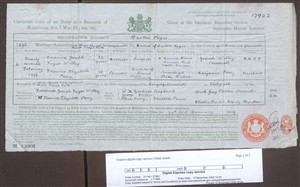Family life

Certificate of Marriage between Florence Parry and Frederick Willey, 1896
National Archives
Marriage, divorce and remarriage
By Claudia Jessop
In 1896, aged 28, Florence married Frederick George Ingor Willey, a 32-year-old surgeon then living in Crouch End (she was living at Stoke Bishop in Gloucestershire). His father, Josiah Willey, had been a fellow of the Royal College of Surgeons. The marriage took place at Christ Church Congregational Church in Barton Regis in the county of Bristol and Gloucester, and her ‘rank’ or profession is given on the marriage certificate as “Bachelor of Science, London University.” The couple took up residence in Avenue Road, Highgate, where he also had his consulting rooms. The 13-year marriage was evidently a disaster; Frederick Willey was violent and abusive, subjecting his wife to such cruelty that “her health greatly suffered”, and Florence was granted a divorce from him in 1909, by which time she was living at 1a Devonshire Street, Portland Place. The couple had no children.
Her second marriage took place seven years later, when she was 49. Her second husband, Sir William Fletcher Barrett FRS, was 72 at the time of their marriage. Their marriage announcement in the Times describes him as being “of Kingstown, Co. Dublin”. He had been Professor of Physics at the Royal College of Science for Dublin between 1873 and 1910, and had been knighted in 1912. Their union lasted nine years, which they spent living at 31 Devonshire Place; he died there from a heart attack in 1925. She was devoted to her husband, and their writings show that it was a deeply loving and happy marriage, enriched by shared interests such as psychical research. She was passionate about the benefits of such intimate and happy partnerships. One of her objections to the use of contraceptives was that it would “interfere with the natural course of lovemaking”, and “degrade it to the grossly physical”. In March 1934, nine years after her husband’s death, she chose “Ideal Marriage” as her subject for the Alliance of Honour Lecture for Women, and in 1938 she led an appeal for funds for the recently created Marriage Guidance Council. During the war, she headed an appeal to raise money for Red Cross ambulances.
She died at Maidenhead, Berkshire on 7 August 1945. Her obituary in the Times declared that “she was unquestionably one of the most distinguished of medical women”. A memorial service was held for her at St Martin’s in the Fields. In her Will she left her husband’s library to the Society for Psychical Research, and endowed a scholarship for the Royal Free Hospital School of Medicine for Women.
This page was added by
Lisa Rigg on 21/12/2009.